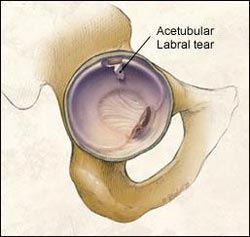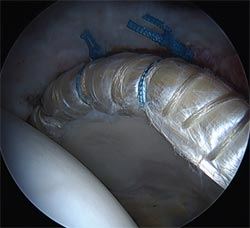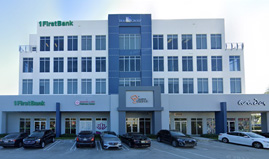Hip Labral Tears/Cartilage Tears
The labrum (or “lip”) is a cartilage ring that lines the hip socket similar to the labrum of the shoulder joint. It serves several functions including: 1) to ensure a smooth and even contact pressure between the hip head and acetabulum, 2) keeping the head from dislocating out of the acetabulum, and 3) dispersing the synovial fluid that bathes the articular cartilage with nutrients. It therefore helps to protect the smooth articular cartilage that lines the bones in our joints. This smooth, white articular cartilage that lines every joint in our body allows for a low friction environment for the millions of cycles the hip goes through each year. Without an intact acetabular labrum, the hip articular cartilage sees increased joint reactive pressures. This can lead to fissures, thinning, and eventual delamination of the cartilage from the bone. These areas can be relatively small or can involve substantial portions of the acetabular cartilage. As the femoral head cartilage grinds against exposed bone surfaces, its articular cartilage also becomes fissured, thinned, and eroded. This is the process whereby the hip joint develops osteoarthritis.

Depending on the size, location, and cause of the tear, the labrum may heal on its own or require surgery. Your doctor may recommend a course of rehabilitation. If symptoms persist, you may be indicated for an arthroscopic evaluation and treatment of the tear.
Surgery is often readily performed arthroscopically with the insertion of an arthroscopic camera through minimally-invasive portals. The labrum can then be visualized and can be repaired or debrided. Repair may entail the insertion of a suture across the tear or a suture anchor that is placed into the bone and used to tie the labrum back to the bone. The cause of the tear such as a CAM or PINCER impingement can also be addressed arthroscopically. In the case of hip impingement, a prominent bony spur might be removed from the acetabulum or femur neck to prevent further labrum tears. Furthermore, areas of exposed bone or deficient cartilage can be repaired.
The surgery is performed on an outpatient (day surgery) basis, so an overnight stay in the hospital is not usually necessary. Rehabilitation is paramount to a successful outcome after surgery.
Common Questions Regarding Labrum/Labral Tears and Hip Arthroscopic Surgery
- Falls, twisting injuries.
- Tears can happen over time and repetitive use.
- Activities: golf, hockey, soccer, football, yoga, dance.
- Tears can happen with impingement.
- The labrum can become trapped between the femoral head and socket (acetabulum)
- Labrum can tear when it is trapped
- Otherwise known as Femoroacetabular Impingement (FAI).
- Labrum tears can happen at any age.
- Young active adolescents, amateur and professional athletes.
- Middle-aged and elderly tend to have degenerative tears.
- Groin pain.
- Sensations of hip “snapping”, “giving-way” or “catching”.
- Pain can happen with walking, running, stairs, twisting motion, and hip bending activities.
- Degenerative, flap, radial
- By careful examination of the hip.
- By MRI scan or by arthroscopic surgery.
- Physical therapy.
- Activity modification.
- Anti-inflammatories (Motrin, Aleve) or Tylenol.
- Injection with cortisone and or hyaluronic acid.
- Some tears may heal with time.
- Some may become larger.
- The location and size of the tear influence the healing potential.
- Tears that have been present for several months or years (chronic) may also have low healing potential.
- Tears that do not heal may lead to joint arthritis.
- Pain may potentially eventually improve.
- Pain may potentially worsen.
- Tears may become larger with time.
- Tears may not be repairable if too much time has elapsed.
- Tears can lead to hip arthritis.
- If you continue to have pain despite therapy and medications.
- Tears with potential for a suture repair are best treated early.
- If there is a significant impingement lesion of the hip leading to the labrum tear and eventual arthritis.
- Age in and of itself is not the limiting factor.
- The amount of pre-existing hip arthritis and possibly even osteoporosis may determine if you are an ideal candidate for surgery.
- A careful pre-operative assessment with your medical internist can determine if you are a candidate for surgery.
- The surgery is performed with a minimally invasive arthroscopic technique.
- Often, the procedure is performed completely with three or four small arthroscopic ¼ inch incisions around the hip.
- Debridement - The normal labrum is left intact. The torn fragment may then be excised using arthroscopic instruments.
- Labrum repair – The labrum may be repaired using sutures.
- Femoroacetabular Impingement Resection – The bony prominences are resected; the labrum may be then repaired or debrided.
- Reconstruction - If the labrum has significant damage that precludes repair, it may be reconstructed.
- Labrum repairs are most successful if the tear is a relatively new and small tear with adequate blood supply.
- In those patients with femoroacatabular impingement or FAI, the bony prominences leading to labral tears and cartilage tears of the hip are resected.
- Your doctor will be able to determine if you are a candidate for labrum repair surgery.
- Labral debridement
- Labral reconstruction
- In the event that the labrum is severely torn and cannot be repaired, then the labrum may reconstructed and re-created using either allograft (cadaver) or autograft (your tissue).
- The graft is prepared outside the hip and then transferred into the hip joint and sutured in place.
- This restores the labrum function in the hip

- Labral tears that are not considered repairable in younger patients who otherwise have healthy articular cartilage on the acetabulum and femoral head, may be candidates for a labrum allograft procedure.
- Your doctor will be able to determine if you are a candidate for labrum repair surgery.
- Dr. Hommen performs labral/labrum reconstruction surgery.
- A camera is inserted into the hip and images are viewed via a video monitor.
- The labrum and other hip problems can be addressed.
- A less invasive procedure with the benefits of:
- less surgical dissection.
- less surgical pain.
- faster recovery rates.
- better visualization of the hip anatomy.
- Arthroscopies are performed under a combination of regional and general anesthesia.
- Nerve blocks can be used for the procedure.
- General anesthesia is when the patient is completely asleep.
- A nerve block may be performed for pain relief after surgery.
- Our dedicated team of anesthesiologists will be able to advise you as to which type anesthesia is best for your procedure.
- Do NOT make any important decisions after surgery since sedatives and other medications are given during the case.
- You may take most of your regularly scheduled medications.
- Certain medications must be stopped before surgery (such as blood thinners). A complete list will be given to you by our office staff.
- Do not eat or drink after midnight before your surgery.
- On the night before the surgery you will called by the hospital surgical team. The will discuss:
- When to arrive for your surgery
- When you can eat
- They will also answer questions you may have concerning medication, transportation, and other concerns.
- The majority of arthroscopic cases are outpatient procedures and patients are allowed to go home the same day of their procedure.
- In certain cases, patients may stay overnight for observation at the hospital and will be allowed to go home in the morning after surgery.
- Patients who have a nerve block, will have prolonged anesthesia to the hip and leg and may go home with the leg still “numb”.
- Therefore, be careful to avoid any pressure, prolonged ice exposure, or injury to the leg as you will not have sensation until the block has worn off.
- You should arrange transportation with family, friends, or other means for after surgery.
- You will not be allowed to drive home after the procedure.
- As with any surgery, there will be surgical pain. The benefit of arthroscopic surgery is the limited amount of surgical dissection and injury to the hip and faster recovery time.
- You will be prescribed narcotic medication to go home with.
- Do NOT make important decisions while taking narcotic medications.
- Keep the incisions clean, dry and intact.
- You will be informed of your weight bearing status after the case.
- In the case of labrum repair, you may not place weight on the lower extremity.
- If an impingement resection is performed, you may not place full weight on the lower extremity.
- In the case of a labrum resection, you will probably be able to place full weight on the lower extremity if no other cartilage or ligament repair was performed.
- You will be given crutches or other assistive devices for walking in the hospital.
- Do NOT make important decisions immediately after surgery or while on narcotic medications.
- Do not bathe or submerge the hip in a pool until Dr. Hommen has cleared you for such activity.
- You may shower after 72 hours if the incisions are dry.
- You may remove the hip dressings after 72 hours.
- Please do NOT remove the white sticky “steri-strips” otherwise known as butterfly stitches.
- Towel-dry the incision after showering.
- You may be given a ted-hose stocking after surgery.
- This helps prevent swelling in the foot, ankle and knee after surgery.
- It also helps reduce the risk of blood clots after surgery.
- Wear the stockings at least 2 weeks after surgery, however, 4 weeks is ideal.
- The majority of patients do not need a blood thinner after surgery as the risk of medications may out-weigh the risks of blood clots.
- There is less than 1 to 5% chance of a pulmonary embolism after hip arthroscopy.
- If you have risk factors for blood clots (previous blood clot, family history of blood clot), then you may require prophylaxis with a blood thinner after surgery.
- Patients may choose to be anti-coagulated after surgery and will be provided medications.
- If you are not allergic to aspirin and you are at low risk for a blood clot, you may be recommended to take 81milligrams of Aspirin daily for 10-14 days from surgery to serve as blood clot prevention.
- You will be prescribed a narcotic for pain relief after surgery.
- You should continue the medications for the first 72 hours as directed and then wean the medications when you are able.
- Certain patients will require a specialized brace after surgery.
- Immobilization may be used to protect labrum repairs.
- Therapy begins according to a strict therapy schedule usually
- Physical therapy continues over a 4 to 16-week period depending on what was procedure was performed.
- Patients undergoing labrum debridement are allowed to return to full activities by 4-6 weeks.
- It will take approximately 4-6 months before returning to full activities after labrum repair.
- Patients undergoing impingement resection of the hip may require 4-6 months before returning to full activities.
- Return to full activity depends on the size of the tear, activity requirements, the size of the resection, the amount of cartilage degenerative changes in the hip, or the repair strength.
- Each patient rehabilitates at his or her own pace and the above are generalized guidelines.
- Each patient has an individually designed rehab program.
- Therapy is performed with a licensed therapist usually at approved outpatient therapy centers.
- Dr. Hommen will tailor a therapy protocol according to your needs that the therapist will follow.
- Each patient will respond differently to arthroscopy.
- If the labrum is repaired with sutures or the impingement lesions are resected, expect a restricted return to driving until directed by the doctor.
- If the torn labrum fragment is excised, patient may resume driving when control of function is restored (usually over the course of a few days to a few weeks).
Hip Chondral Lesions
- Falls, twisting injuries.
- Tears can happen over time and repetitive use.
- Activities: golf, hockey, soccer, football, yoga, dance.
- Tears can happen with impingement.
- The chondral surface can become brittle and frayed with repetitive impingement of the hip. Eventually, the cartilage may debond from the acetabulum socket or femoral head.
- Otherwise known as Femoroacetabular Impingement (FAI).
- Chondral lesion can happen at any age.
- Young active adolescents, amateur and professional athletes.
- Middle-aged and elderly tend to have degenerative tears.
- Groin pain.
- Sensations of hip “snapping”, “giving-way” or “catching”.
- Pain can happen with walking, running, stairs, twisting motion, and hip bending activities.
- By careful examination of the hip.
- By MRI scan or by arthroscopic surgery.
- Physical therapy.
- Activity modification.
- Anti-inflammatories (Motrin, Aleve) or Tylenol.
- Injection with cortisone and or hyaluronic acid.
- Weight loss is also helpful in reducing the pressure on the cartilage.
- Some tears may heal with time.
- Some may become larger.
- The location and size of the tear influence the healing potential.
- Tears that have been present for several months (chronic) may also have low healing potential.
- Tears that do not heal may lead to joint arthritis.
- Pain may potentially eventually improve.
- Pain may potentially worsen.
- Tears may become larger with time.
- Tears may not be repairable if too much time has elapsed.
- Tears can lead to hip arthritis.
- If you continue to have pain despite therapy and medications.
- Tears with potential for a repair are best treated early.
- If there is a significant impingement lesion of the hip leading to the labrum tear and eventual arthritis.
- Age itself is not the limiting factor.
- A careful pre-operative assessment with your medical internist can determine if you are a candidate for surgery.
- The surgery is performed with a minimally invasive arthroscopic technique.
- Often, the procedure is performed completely with three or four small arthroscopic ¼ inch incisions around the hip.
- Debridement - The normal chondral cartilage is left intact. The torn fragment may then be excised using arthroscopic instruments.
- Repair – The labrum and the chondral surface may be repaired using sutures.
- Femoroacetabular Impingement Resection – The bony prominences are resected, the labrum may be then repaired.
- Microfracture – a marrow stimulation procedure whereby a small drill is used to penetrate the bone at the are of the chondral lesion. By creating multiple small holes, underneath the damaged cartilage, this allows the marrow cells deep within the bone to come to the surface and form a clot. These cells can create a cartilage-like material called fibrocartilage which covers the area of the chondral injury and can provide significant improvement in pain.
- MACI – Matrix Induced Autologous Chondrocyte Implantation – is a procedure whereby the cartilage is harvested from elsewhere in the hip and is then sent to a laboratory where the cells are stimulated to grow and multiply. These same cells are then placed on a biologic collagen scaffold and then re-implanted at a later date back into the hip joint by gluing the collagen scaffold into the chondral defect in the hip.
- Chondral repairs are most successful if the tear is a relatively new and small tear with adequate blood supply.
- In those patients with femoroacatabular impingement or FAI, the bony prominences can lead to concomitant labral tears as well. Impingement bone prominences are therefore resected.
- Your doctor will be able to determine if you are a candidate for cartilage repair surgery.
- A camera is inserted into the hip and images are viewed via a video monitor.
- The labrum, chondral lesion and other hip problems can be addressed.
- A less invasive procedure with the benefits of:
- less surgical dissection.
- less surgical pain.
- faster recovery rates.
- better visualization of the hip anatomy.
- Arthroscopies are performed under a combination of regional and general anesthesia.
- Nerve blocks can be used for the procedure.
- General anesthesia is when the patient is completely asleep.
- A nerve block may be performed for pain relief after surgery.
- Our dedicated team of anesthesiologists will be able to advise you as to which type anesthesia is best for your procedure.
- Do NOT make any important decisions after surgery since sedatives and other medications are given during the case.
- You may take most of your regularly scheduled medications.
- Certain medications must be stopped well before surgery (such as blood thinners). A complete list will be given to you by our office staff.
- Do not eat or drink after midnight before your surgery.
- On the night before the surgery you will called by the hospital surgical team. The will discuss:
- When to arrive for your surgery
- When you can eat
- They will also answer questions you may have concerning medication, transportation, and other concerns.
- The majority of arthroscopic cases are outpatient procedures and patients are allowed to go home the same day of their procedure.
- In certain cases, patients may stay overnight for observation at the hospital and will be allowed to go home in the morning after surgery.
- ·Patients who have a nerve block, will have prolonged anesthesia to the hip and leg and may go home with the leg still “numb”.
- Therefore, be careful to avoid any pressure, prolonged ice exposure, or injury to the leg as you will not have sensation until the block has worn off.
- You should arrange transportation with family, friends, or other means for after surgery.
- You will not be allowed to drive home after the procedure.
- As with any surgery, there will be surgical pain. The benefit of arthroscopic surgery is the limited amount of surgical dissection and injury to the hip and faster recovery time.
- You will be prescribed narcotic medication to go home with.
- Do NOT make important decisions while taking narcotic medications.
- Keep the incisions clean, dry and intact.
- You will be informed of your weight bearing status after the case.
- In the case of labrum repair, you may not place weight on the lower extremity.
- If an impingement resection is performed, you may not place full weight on the lower extremity.
- In the case of a labrum resection, you will probably be able to place full weight on the lower extremity if no other cartilage or ligament repair was performed.
- You will be given crutches or other assistive devices for walking in the hospital.
- Do NOT make important decisions immediately after surgery or while on narcotic medications.
- · Do not bathe or submerge the hip in a pool until Dr. Hommen has cleared you for such activity.
- · You may shower after 72 hours if the incisions are dry.
- You may remove the hip dressings after 72 hours.
- Please do NOT remove the white sticky “steri-strips” otherwise known as butterfly stitches.
- Towel-dry the incision after showering.
- You may be given a ted-hose stocking after surgery.
- This helps prevent swelling in the foot, ankle and knee after surgery.
- It also helps reduce the risk of blood clots after surgery.
- Wear the stockings at least 2 weeks after surgery, however, 4 weeks is ideal.
- The majority of patients do not need a blood thinner after surgery as the risk of medications may out-weigh the risks of blood clots.
- There is less than 1 to 5% chance of a pulmonary embolism after hip arthroscopy.
- If you have risk factors for blood clots (previous blood clot, family history of blood clot), then you may require prophylaxis with a blood thinner after surgery.
- Patients may choose to be anti-coagulated after surgery and will be provided medications.
- You will be prescribed a narcotic for pain relief after surgery.
- You should continue the medications for the first 72 hours as directed and then wean the medications when you are able.
- Certain patients will require a specialized brace after surgery.
- Therapy begins according to a strict therapy schedule usually
- Physical therapy continues over a 4 to 16-week period depending on what was procedure was performed.
- Patients undergoing labrum debridement are allowed to return to full activities by 4-6 weeks.
- It will take approximately 4-6 months before returning to full activities after labrum repair.
- Patients undergoing impingement resection of the hip may require 4-6 months before returning to full activities.
- Return to full activity depends on the size of the tear, activity requirements, the size of the resection, the amount of cartilage degenerative changes in the hip, or the repair strength.
- Each patient rehabilitates at his or her own pace and the above are generalized guidelines.
- Each patient has an individually designed rehab program.
- · Therapy is performed with a licensed therapist usually at approved outpatient therapy centers.
- · Dr. Hommen will tailor a therapy protocol according to your needs that the therapist will follow.
- Each patient will respond differently to arthroscopy.
- If the labrum is repaired with sutures or the impingement lesions are resected, expect a restricted return to driving until directed by the doctor.
- If the torn labrum fragment is excised, patient may resume driving when control of function is restored (usually over the course of a few days to a few weeks).













